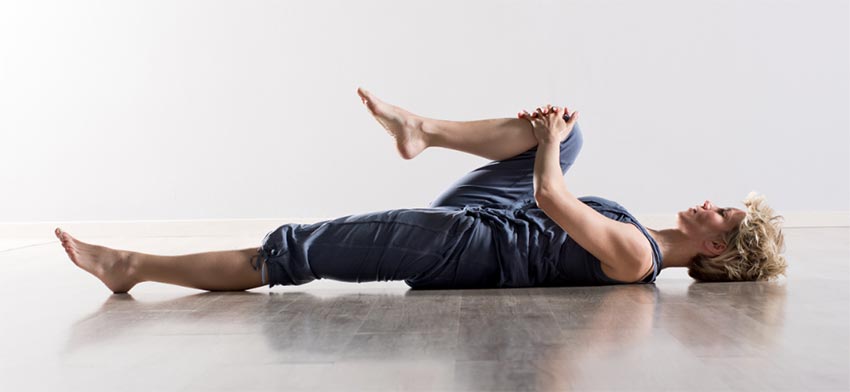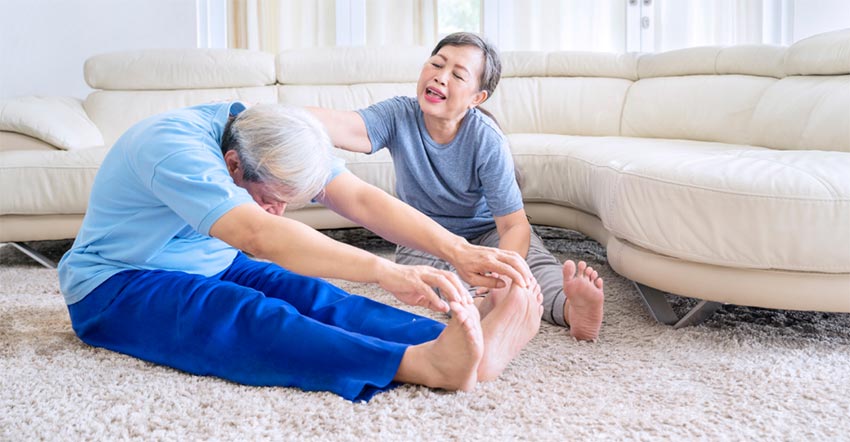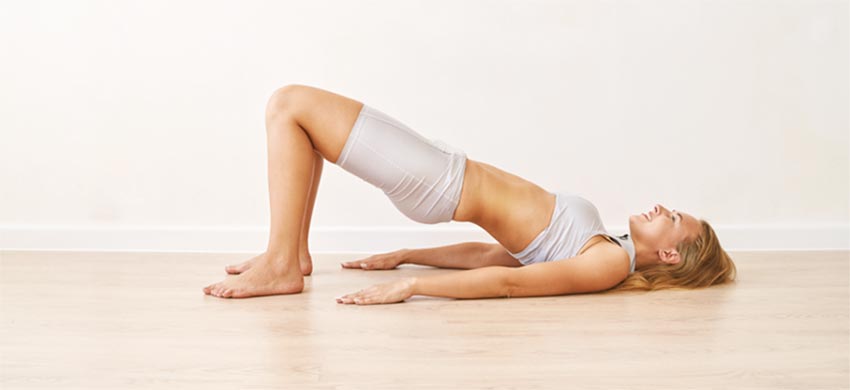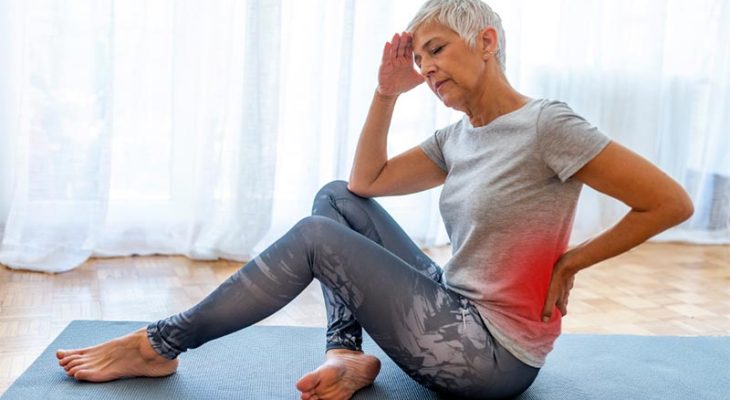Having lower back pain isn’t fun, especially if you’re at the age where everything feels as if it hurts three times more. However, there’s a way to exercise at home to reduce the lower back pain, eliminate it, and relieve the symptoms.
If that’s what you’re looking for, you’re in the right place. Down below, we will show you the 15 best exercises for seniors at home, so if you’re feeling back pain as you’re reading this, give these a try right after you’re done reading!
15 Best Exercises for Seniors at Home for Lower Back Pain
With so many different exercises for lower back pain, it can be tricky to choose the right ones for seniors. If you’re worried about injuring your lower back further, rely on these exercises as these are the best picks for seniors.
1. Pelvic Tilts
Pelvic tilts are one of the exercises that are still fairly easy to do for seniors, even if you’re experiencing pain or discomfort due to lower back issues. By getting in the position for a pelvic tilt (lying on your back), keep your knees bent while you tighten your stomach and core.
Make sure your back is flat to the surface hold the tension for a few seconds and then release. Pelvic tilts provide strength for abdominal muscles, and stabilization in the lower back, and can also be a pain relief. This way, you can build the surrounding muscles that will help ensure your lower back isn’t the weakest link of your back.
2. Walking
Walking is a great alternative if you’re in such severe pain that you don’t think you can do any other exercise, especially the ones such as pelvic tilts. Walking can still be beneficial, and if you have a garden or a yard to walk around, you’ll have much more fun than getting your steps in the house.
The great thing about walking is that it’s a low-impact exercise and it can offer more benefits than just relieving your lower back pain. Besides that, you can also benefit from improved circulation, cardiovascular health, and improved muscle strength. It can even have positive mind benefits so it’s a good start if you’re in severe pain before you proceed to other exercises.
3. Chair Squats
Chair squats are easy to do and you only need a chair. By standing in front of the chair, lower yourself until your bottom touches the chair, and then instead of sitting down, immediately stand up. Repeat as many times as you can. We highly recommend doing a couple of sets with several repetitions in each set.
The great thing bout chair squats is that it’s simple to handle, you can’t injure yourself further, yet they can help strengthen thigh muscles and even stabilize the knees. This can lead to a better lower back posture and strengthen the surrounding muscles.
4. Bird Dog
If you’re feeling flexible and your lower back pain allows you to still do a bit more complex exercises, then a bird dog is a great exercise you should try. Bird dog means you should kneel on all fours, and then extend one leg and the opposite arm simultaneously. Hold it there for a few seconds and then make the switch (do the other leg and the other arm).
This is a great exercise that doesn’t require you to have any equipment and it’s not hard to do, but it can improve balance and stabilize the lower back. With the proper lower back stabilization, you might feel pain relief and most importantly, your lower back will be less prone to painful injuries.
5. Wall Sits
Wall sits are very similar to chair squats and are an even easier way to do it if you don’t have a chair around. All you need is a wall where you need to stand about 10 inches from the wall. The exercise is done by leaning back until your back touches the wall, but make sure that your back is fully flat against the wall behind you.
When it is, slide down while relying on your hips and legs to a seated position and try to hold the position for as long as possible. This can help improve the back muscles, but also the overall core and muscles surrounding the knees, resulting in a stabilized back that will be less prone to injuries.
6. Knees to Chest Stretches
If you’re struggling doing any of the harder exercises, but you find walking too easy, knees-to-chest stretching is a good exercise to try.

The great thing about the knees to chest stretches is that you can lay on a comfortable surface and fully rely on your back, while still keeping the legs in the air, bent in the knees. When you’re in the position, pull your knees towards your chest, hold it for a few seconds, and then return to the starting position.
We recommend doing this exercise in a couple of sets with several repetitions in each set.
7. Heel Raises
If you feel like the lower back pain is caused from below, including your ankles, knees, and legs – then heel raises make a super beneficial exercise to tackle down lower back pain.
For better support, we recommend getting a chair you can put behind yourself. Then, lift your heels off the ground, hold for a few seconds at the highest position, and slowly lower them down. The point of this purpose is to stabilize knee muscles and provide better knee joint support.
8. Seated Spinal Twist
To do seated spinal twists, you only need a chair that won’t limit your movements. When you’re seated, this exercise is all about twisting your torso to one side, holding it for a few seconds, and then returning to the starting position. After that, do the same in the opposite direction.
We recommend holding for the back of the chair for better support and a better lower back pain stretch. The point of this exercise is to improve spinal flexibility for better support.
9. Press Up Back Extension
Press up back extension is an exercise that’s similar to the knees to the chest exercise, but with this exercise, you need to lie down on your stomach. When you’re lying on the floor, put your hands on the shoulders and gently try to press up.
You should feel as if you’re lifting your shoulders from the ground, and this is the whole point of the exercise where you will work to strengthen back muscles. Strengthening the back muscles will help stabilize the lower back a lot more, reducing the risk of lower back injury or even pain after standing in the same spot for a longer period.
10. Side Bends
Side bends is a similar exercise to the seated spinal twist, but it’s a great alternative for those who feel like their lower back pain is greatly limiting their motion. With side bends you should be standing up and have your feet spread shoulder-width apart.
When you’re ready and in the position, slide one hand down the opposite leg and see how far you can slide the hand. This is one of the best ways to stretch your lower back without feeling too much discomfort or pain. This helps stretch the muscles surrounding the lower back, which is mostly the area where you’re experiencing the pain.
We recommend trying to push yourself a bit further every time but don’t overdo it, or don’t stretch too far if you feel like you can’t do it safely.

11. Hamstring Stretch
The hamstring stretch is an exercise that combines a few similar exercises. To perform it, you will need a chair where you will sit on its edge. From there, extend one leg in front, lean slightly forward, and ensure your back is straight.
You will start feeling a stretch in the hamstring and the key is to gently move forward without forcing the motion. You’ll notice how you can lean forward more and more as you stretch your hamstrings, and this will be good for stretching the lower back muscles.
12. Toe Taps
Toe taps are another great exercise for seniors at home for lower back pain that involves a chair. If you don’t feel strong or flexible enough, toe taps can help improve circulation throughout your body, as well as improve the angle flexibility.
If you think some of the other exercises are out of reach due to your lower back pain, you can use toe taps as a warm-up exercise.
To do toe taps, sit in a chair and keep your heels off the ground by lifting the legs on your toes. After that, alternate and lift your heels while keeping your toes on the ground.
13. Arm Reaches
If you feel like you lack mobility or strength to do some other exercise from the list, arm reaches is a great starting point. While we recommend doing it seated in a chair, it’s also something you can do standing.
The whole exercise is all about extending your arms overhead. From there, hold the position. You can alternate the exercise by extending your arms sideways as well, holding for as long as you comfortably can.
The whole point of this exercise is to improve shoulder mobility and back strength.
14. Partial Crunches
Crunches might be a hard exercise if you’re feeling a great amount of lower back pain. However, partial crunches are the next best thing you can do to strengthen the core and reduce back pain.
To do partial crunches, have your knees bent and feet flat, and do small controlled crunches. It’s all about having control over your crunches, keeping it steady, and trying not to injure your back any further. However, partial crunches will reduce the pressure on your spine, which is why we believe it’s one of the best exercises for seniors at home to deal with lower back pain.
15. Bridge Exercise
If you’re feeling a bit of pain but still feel like you can do almost any exercise from this list, then a bridge exercise could be a good challenge. Bridge exercise is all about lying on your back with your knees bent and feet flat on the floor.

From there, lift yourself up by lifting the hips up towards the ceiling, for as many seconds as you can. After you can’t hold the position any longer, slowly return to the starting position. This should strengthen the buttocks and lower back directly. We recommend doing it in sets with a comfortable number of repetitions.
Conclusion
Lower back pain can feel like it can keep you in bed and put your day to a stop. Being a senior, feeling the back pain can feel extreme at times. Even if you don’t feel like you can get any of these exercises done right, it’s a good idea to push yourself a bit. However, try not to injure yourself further, but push yourself to the point that is just slightly uncomfortable.
These exercises are meant to target different muscles around the back, shoulders, buttocks, and legs. At the same time, you’ll almost always activate your core, ensuring you work on the strength, but also stretch out the muscles you might’ve never stretched. This itself should feel like a big relief, so stay consistent in doing these exercises daily!
FAQs (Frequently Asked Questions)
What is the best exercise for lower back pain for seniors?
The best exercise for lower back pain for seniors is the pelvic tilts. It’s not too difficult to do but it provides plenty of benefits in return.
What is the single best exercise for lower back pain?
The single best exercise for lower back pain is the bridge exercise, as long as you can perform it correctly without feeling too much pain. It helps stretch and work on the lower back muscles.
How do you treat lower back pain in the elderly?
Lower back pain in the elderly is best treated with stretches and exercises that can strengthen the surrounding muscles.
What exercise can a person do with severe back pain?
Exercises involving a chair are fairly easy to do for people with severe back pain, such as seated spinal twists or chair squats. If you’re feeling an incredible amount of pain, walking is a great way to warm your back.
What can cause severe lower back pain in the elderly?
Anything from disc diseases, strain, spinal stenosis, and fractures, to spinal infection or osteoarthritis, among others can be a cause of back pain in the elderly.
Is back pain normal for aging?
Unfortunately, yes, back pain is considered normal for aging since it is something that can be affected by many causes, that are also related to aging.





